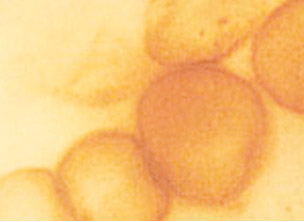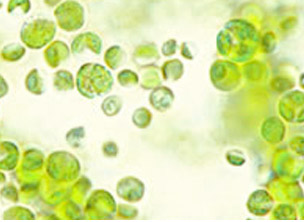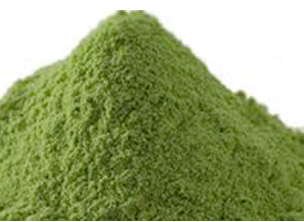What is Chlorella?
- HOME
- What are functional plants?
- What is Chlorella?
- What are functional plants?
- What is Chlorella?
- What is Eleuthero?
- What is Agaricus?
- What is Soba (fagopyrum spp.)?
- What is Mulberry?
"Chlorella" which have not changed since it was born
Single-celled green algae born with the diversity of organisms and grows in fresh water
"Chlorella" is a single-celled green algae that grows in fresh water, and it has several species such as "pyrenoidosa", "vulgaris" and "sorokiniana". The origin of Chlorella was 540 million years ago; it was Cambrian period, increased the variety of life.

Chlorella is invisible to the naked eye.
M.W.Beijerrinck, the Dutch microbiologist, introduced Chlorella for the first time about 130 years ago, that is in 1890.
M.W.Beijerrinck named the small plant of what he found by using a microscope, "Chlorella". Chlorella was named after "chlor" which means green in Greek and "ella" which means a small thing in Latin.

"Chlorella" using the power of sun
The property of plants and usage for food
Unlike animals, plants carry on photosynthesis, the process that plants produce the glucose and oxygen from water and carbon dioxide by using sunlight.
Chlorella had been used as materials for study to clarify the mechanism of photosynthesis, however it is known that dried Chlorella, grown in a good environment, contains about 60% of protein and vitamins, so it is considered to use chlorella for food.

Two reasons why researchers of the time took notice of "use of chlorella as food"
Vegetables that we eat are a part of fruits, leaves and roots of plants. These parts store essential nutrients to live and leave seeds. However, the weight of these nutrients are less than half of that of plants. There are two reasons. At first, plants are succulent. Secondly, they have structures that we cannot eat such as roots which fix themselves and absorb nutrients and moisture from soil, leaves which utilize sunlight and stems which fix leaves and fruits.
In addition, it shows that the yields are limited due to the area of plants.
However, the construction of Chlorella is only cell wall, so the efficient usage of nutrients, the appropriate temperature, sunlight and nutrients make the amount of yield from Chlorella high.
Therefore, Chlorella was expected to resolve the shortage of food caused by rapid population growth.
Problem regarding the shortage of food still remains, but Double Burden Malnutrition (DBM: It is characterized by the coexistence of undernutrition along with overnutrition within individuals, households, regions and countries.) occurs in the world.
Moreover, it is discussed that effects to our bodies differ depending on the method of taking food components in addition to the quantity and quality of them.
Now, it is expected that Chlorella resolve these problems by its various nutrients and ingredients.
Chlorella is a small and high quality green algae.
Chlorella is a whole food.
Chlorella is round in shape and 2-10 μm in size, smaller than erythrocytes in our bodies. It looks green because it contains a lot of chloroplasts. Dried Chlorella tablet is very common. 100g of Chlorella contains about 60g of protein, and it is rich in various nutrients, such as mineral, lutein, folic acid, B6, B12 and vitamins including carotene.
In addition, the biggest difference between Chlorella and other foods is that Chlorella is a whole food. Organisms take essential ingredients from the outside and deliver them to proper places.
As an example, it is known that nutrients such as carotene converted to vitamin A, and vitamin B12 are absorbed as much as necessary. Single-celled Chlorella is said that it has appropriate quantity and quality of ingredients to live, and it enable creatures to provide essential ingredients efficiently.

Chlorella contains healthy ingredients which work in our bodies.
It is reported that taken ingredients work in our bodies.
Chlorella contains a lot of nutrition and healthy ingredients, but there are still unknown factors about it.
In addition, nowadays it is discussed whether its ingredients are used in our body or not. However, the usage situation and effectiveness of health ingredients such as lutein are revealed.
Of course, Chlorella contains a lot of ingredients; therefore, we cannot assert that these effect are caused by a single ingredient.


